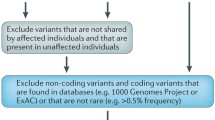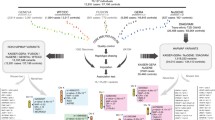Abstract
Genome-wide scans for linkage have provided one of the dominant approaches adopted by researchers in their efforts to identify genes responsible for the inherited component of type 2 diabetes susceptibility. Around 20 genome scans have now been completed, in a wide variety of populations. Integration of data from these diverse scans has proven far from trivial, but the contours of genome-wide linkage topography are steadily emerging from the fog of data. Identification of the calpain- 10 gene as the probable basis for the chromosome 2q linkage seen in Mexican Americans has provided validation of this positional cloning approach. This report provides an update on recent type 2 diabetes genome scan data, focusing on several chromosomal regions where the evidence for linkage has considerably strengthened in the past year. The current and future value of genome-wide linkage information in the search for type 2 diabetes susceptibility effects is also discussed.
Similar content being viewed by others
References and Recommended Reading
Zimmet P, Alberti KG, Shaw J: Global and societal implications of the diabetes epidemic. Nature 2001, 414:782–787.
Lander ES, Schork NJ: Genetic dissection of complex traits. Science 1994, 265:2037–2048.
Hirschhorn JN, Lohmueller K, Byrne E, Hirschhorn K: A comprehensive review of genetic association studies. Genet Med 2002, 4:45–61. An impressive survey and analysis of the literature of published association studies, documenting the poor history of such studies and suggesting remedies and future standards.
Cardon LR, Bell JI: Association study designs for complex disease. Nat Rev Genet 2001, 2:91–99.
Wright AF, Hastie ND: Complex genetic diseases: controversy over the Croesus code. Genome Biol 2001, 2:2007.1–2007.8. Accessible online at http://genomebiology.com/2001/2/8/comment/2007. A well-argued commentary on the argument raging between those who believe that many important complex trait susceptibility effects will be conveyed by common variants (ie, the common disease, common variant hypothesis) and those who believe that extensive allelic heterogeneity will be typical. This argument has considerable implications for our ability to detect susceptibility effects using linkage disequilibrium tools.
Owen K, Hattersley AT: Maturity-onset diabetes of the young: from clinical description to molecular genetic characterization. Best Pract Res Clin Endocrinol Metab 2001, 15:309–323.
Hanis CL, Boerwinkle E, Chakraborty R, et al.: A genomewide search for human non-insulin-dependent (type 2) diabetes genes reveals a major susceptibility locus on chromosome 2. Nat Genet 1996, 13:161–171.
Mahtani MM, Widén E, Lehto M, et al.: Mapping of a gene for NIDDM associated with an insulin secretion defect by a genome scan in Finnish families. Nat Genet 1996, 14:90–95.
Hanson RL, Ehm MG, Pettitt DJ, et al.: An autosomal genomic scan for loci linked to type 2 diabetes mellitus and body-mass index in Pima Indians. Am J Hum Genet 1998, 63:1124–1132.
Pratley RE, Thompson DB, Prochazka M, et al.: An autosomal genomic scan for loci linked to prediabetic phenotypes in Pima Indians. J Clin Invest 1998, 101:1757–1764.
Duggirala R, Blangero J, Almasy L, et al.: Linkage of type 2 diabetes mellitus and of age at onset to a genetic location on chromosome 10q in Mexican Americans. Am J Hum Genet 1999, 64:1127–1140.
Elbein SC, Hoffman MD, Teng K, et al.: A genomewide search for type 2 diabetes susceptibility genes in Utah Caucasians. Diabetes 1999, 48:1175–1182.
St. Jean P, Hsueh W-C, Mitchell B, et al.: Association between diabetes, obesity, glucose and insulin levels in the old order Amish and SNPs on 1q21-23 [abstract]. Am J Hum Genet 2000, 67(suppl 2):1848.
Ehm MG, Kkarnoub MC, Sakul H, et al.: Genomewide search for type 2 diabetes susceptibility genes in four American populations. Am J Hum Genet 2000, 66:1871–1881.
Ghosh S, Watanabe RM, Valle TT, et al.: The Finland-United States Investigation of non-insulin-dependent diabetes mellitus genetics (FUSION) study. I. An autosomal genome scan for genes that predispose to type 2 diabetes. Am J Hum Genet 2000, 67:1174–1185. Description of the findings from one of the largest genome scans performed to date. These data provided evidence for linkage to chromosome 20 in Finnish subjects with T2D.
Watanabe RM, Ghosh S, Langefeld CD, et al.: The Finland- United States investigation of non-insulin-dependent diabetes mellitus genetics (FUSION) study. II. An autosomal genome scan for diabetes-related quantitative-trait loci. Am J Hum Genet 2000, 67:1186–1200.
Vionnet N, Hani EH, Dupont S, et al.: Genomewide search for type 2 diabetes-susceptibility genes in French Whites: evidence for a novel susceptibility locus for early-onset diabetes on chromosome 3q27-qter and independent replication of a type 2-diabetes locus on chromosome 1q21-q24. Am J Hum Genet 2000, 67:1470–1480.
Parker A, Meyer J, Lewitzky S, et al.: A gene conferring susceptibility to type 2 diabetes in conjunction with obesity is located on chromosome 18p11. Diabetes 2001, 50:675–680.
Permutt MA, Wasson JC, Suarez BK, et al.: A genome scan for type 2 diabetes susceptibility loci in a genetically isolated population. Diabetes 2001, 50:681–685.
Wiltshire S, Hattersley AT, Hitman GA, et al.: A genomewide scan for loci predisposing to type 2 diabetes in a UK population (The Diabetes (UK) Warren 2 Repository): analysis of 573 pedigrees provides independent replication of a susceptibility locus on chromosome 1q. Am J Hum Genet 2001, 69:553–569. Description of the findings from one of the largest genome scans performed to date. These data provided evidence for linkage to chromosome 1q in UK families segregating T2D.
Busfield F, Duffy DL, Kesting JB, et al.: A genomewide search for type 2 diabetes-susceptibility genes in indigenous Australians. Am J Hum Genet 2002, 70:349–357.
Lindgren CM, Mahtani MM, Widen E, et al.: Genomewide search for type 2 diabetes mellitus susceptibility loci in Finnish families: the Botnia Study. Am J Hum Genet 2002, 70:509–516.
Meigs JB, Panhuysen CI, Myers RH, et al.: A genome-wide scan for loci linked to plasma levels of glucose and HbA(1c) in a community-based sample of Caucasian pedigrees: the Framingham Offspring Study. Diabetes 2002, 51:833–840.
Mori Y, Otabe S, Dina C, et al.: Genome-wide search for type 2 diabetes in Japanese affected sib-pairs confirms susceptibility genes on 3q, 15q, and 20q and identifies two new candidate loci on 7p and 11p. Diabetes 2002, 51:1247–1255.
Xiang K, Wang Y, Zheng T, et al.: Genome wide scan for type 2 diabetes susceptibility loci in Chinese. Diabetes 2002, 51(suppl 2):A262.
Wiltshire S, Cardon LR, McCarthy MI: Evaluating the results of genome-wide linkage scans of complex traits by locus counting. Am J Hum Genet [serial online] 2002, 71:1175–1182.
Lander E, Kruglyak L: Genetic dissection of complex traits: guideline for interpreting and reporting linkage results. Nat Genet 1995, 11:241–247.
Cox NJ, Frigge M, Nicolae DL, et al.: Loci on chromosomes 2 (NIDDM1) and 15 interact to increase susceptibility to diabetes in Mexican Americans. Nat Genet 1999, 21:213–215.
Horikawa Y, Oda N, Cox NJ, et al.: Genetic variation in the gene encoding calpain-10 is associated with type 2 diabetes mellitus. Nat Genet 2000, 26:163–175. Horikawa et al. detail the linkage disequilibrium studies that led them to conclude that variation in the CAPN10 gene was responsible for the chromosome 2q linkage that had previously been observed in Mexican- American families [7]. See also the commentary by Altshuler et al. in the same edition of Nature Genetics.
Evans JC, Frayling TM, Cassell PG, et al.: Association studies of the calpain-10 gene with type 2 diabetes mellitus in the United Kingdom. Am J Hum Genet 2001, 69:544–552.
Bowden DW, Sale M, Howard TD, et al.: Linkage of genetic markers on human chromosomes 20 and 12 to NIDDM in Caucasian sib pairs with a history of diabetic nephropathy. Diabetes, 1997, 46:882–886.
Zouali H, Hani EH, Philippi A, et al.: A susceptibility locus for early-onset non-insulin dependent (type 2) diabetes mellitus maps to chromosome 20q, proximal to the phosphoenolpyruvate carboxykinase gene. Hum Mol Genet 1997, 6:1401–1408.
Ji L, Malecki M, Warram JH, et al.: New susceptibility locus for NIDDM is localized to human chromosome 20q. Diabetes 1997, 46:876–881.
Luo TH, Zhao Y, Li G, et al.: A genome-wide search for type II diabetes susceptibility genes in Chinese Hans. Diabetologia 2001, 44:501–506.
Hollstein PE, Silander K, Scott LJ, et al.: Efficient fine-mapping of a type 2 diabetes locus on chromosome 20 through SNP typing on DNA pools [abstract]. Am J Hum Genet 2002, 71(suppl):496.
Shaw JTE, Lovelock PK, Kesting JB, et al.: Novel susceptibility gene for late-onset NIDDM is localized to human chromosome 12q. Diabetes 1998, 47:1793–1796.
Triggs-Raine BL, Kirkpatrick RD, Kelly SL, et al.: HNF-1alpha G319S, a transactivation-deficient mutant, is associated with altered dynamics of diabetes onset in an Oji-Cree community. Proc Natl Acad Sci U S A 2002, 99:4614–4619.
Groves CJ, Wiltshire S, Menzel S, et al.: Linkage studies of the type 2 Diabetes susceptibility locus on chromosome 1q: combined analysis of 1200 UK and French affected sibpairs [abstract]. Diabetologia 2002, 45(suppl 2):A55.
Roberts SB, MacLean CJ, Neale MC, et al.: Replication of linkage studies of complex traits: an examination of variance in location estimates. Am J Hum Genet 1999, 65:876–884.
Gauguier D, Froguel P, Parent V, et al.: Chromosomal mapping of genetic loci associated with non-insulin dependent diabetes in the GK rat. Nat Genet 1996, 12:38–43.
Kissebah AH, Sonnenberg GE, Myklebust J, et al.: Quantitative trait loci on chromosomes 3 and 17 influence phenotypes of the metabolic syndrome. Proc Natl Acad Sci U S A 2002, 97:14478–14483.
Vasseur F, Helbecque N, Dina C, et al.: Single nucleotide polymorphism haplotypes in the both proximal promoter and exon 3 of the APM1 gene modulate adipocyte-secreted adiponectin hormone levels and contribute to the genetic risk for type 2 diabetes in French Caucasians. Hum Mol Genet 2002, 11:2607–2614.
DeWan AT, Parrado AR, Matise TC, Leal SM: The map problem: a comparison of genetic and sequence-based physical maps. Am J Hum Genet 2002, 70:101–107.
Wise LH, Lanchbury JS, Lewis CM: Meta-analysis of genome searches. Ann Hum Genet 1999, 63:263–272.
McCarthy MI, Kruglyak L, Lander ES: Sib pair collection strategies for complex diseases. Genet Epidemiol 1998, 15:317–340.
Goring HHH, Terwilliger JD, Blangero J: Large upward bias in estimation of locus-specific effects from genome-wide scans. Am J Hum Genet 2001, 69:1357–1369. A detailed exploration of the problems associated with using positive results from genome scans as the basis for estimating the effect sizes of the loci detected.
Cox NJ, Wapelhorst B, Morrison VA, et al.: Seven regions of the genome show evidence for linkage to type 1 diabetes in a consensus analysis of 767 multiplex families. Am J Hum Genet 2001, 69:820–830.
Levinson DF, Holmans PA, Laurent C, et al.: No major schizophrenia locus detected on chromosome 1q in a large multicenter sample. Science 2002, 296:739–741. A recent effort to evaluate a region of chromosome 1q implicated in schizophrenia susceptibility by combined analysis of data from a total of 779 schizophrenia pedigrees assembled from eight independently collected samples.
Risch N, Merikangas K: The future of genetic studies of complex human diseases. Science 1996, 273:1516–1517.
Author information
Authors and Affiliations
Rights and permissions
About this article
Cite this article
McCarthy, M.I. Growing evidence for diabetes susceptibility genes from genome scan data. Curr Diab Rep 3, 159–167 (2003). https://doi.org/10.1007/s11892-003-0040-y
Issue Date:
DOI: https://doi.org/10.1007/s11892-003-0040-y




